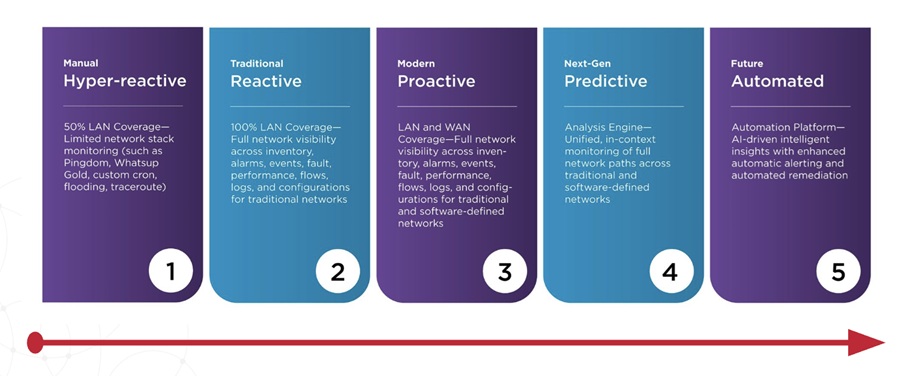If IT operations and support teams seem a bit frazzled these days, it’s perfectly understandable.
They’re constantly being plowed under by the weight of managing multiple mission-critical application technologies that grow more complex by the day. The increasing demand for virtualization, private cloud, composite applications and other “must haves” add to the burden. They’re enhancing the agile, vibrant quality of organizations, but presenting new difficulties for IT Operations.
These are the people who get the frantic calls when things “don’t work right.” They’d like to take a more proactive approach, to spot trouble before transactions and the end user experience are disrupted. Unfortunately, enterprise IT Operations teams too often learn about these problems only after the damage is done. That’s because they’re running 21st Century technologies, but they’re stuck with yesterday’s management tools.
Whether infrastructure monitoring frameworks, log analyzers, or technology specific (silo) tools, these management products can’t tie the infrastructure and technology component management data to the applications and transactions that depend on them. These approaches have created a management data gap, which was highlighted by our recent survey.
Survey Says ...
At BlueStripe, we surveyed 126 IT operations and production support executives at enterprise-level organizations. We were interested about the range of applications they’re responsible for and the most pressing challenges they face. We wanted to know if their management tools were effective enough for them to do their jobs.
The executives responded with a clear “no” on the latter inquiry. Here’s a summary of the survey results:
Application transaction systems have become more complex. How complex? 84 percent of companies have five or more major technologies within their applications, and 64 percent of organizations juggle a staggering seven or more. Note the use of the word “major,” here because applications are no longer as simplistic as a Web server, App server and Database. The drive for better CRM, ERP, BI, e-Commerce and other innovations represent a new order that demands far more command over performance than in the past.
Management tools can’t keep up. 77% of respondents had invested in at least 3 different tools to get control of transaction performance and availability. Even with that level of investment, the majority of executives (roughly six-of-ten) lamented that their tools still fail to work with all the technologies used in the applications.
These circumstances are leading to serious difficulties: 64 percent of our survey participants say that it takes far too long to resolve business-impacting application outages and/or slowdowns. And throwing more tools at the problem doesn’t seem to help. For those respondents that have invested in 3+ tools, the response rate rises to 71%.
Nobody likes surprises, but they still occur. Nearly half of survey respondents say they still only hear about application performance problems when users call in to complain.
The costs of application problems add up: Production transaction problems not only have costs in lost revenue and poor customer satisfaction, but they also halt strategic projects by drawing the Operations team in to solve the problems.
The abundance of major technologies now present in application systems creates a long, interconnected string of co-dependencies, and those co-dependencies are pushing IT Operations to the breaking point. Sixty-one percent of our survey’s participants say their existing application and transaction management products cannot quickly pinpoint the source of trouble. In fact, more than half said their management solutions cannot even support all the technologies that transactions depend upon.
Even those that had all their technologies covered by their tools still couldn’t pinpoint problems because a technology-silo approach can’t deliver data to understand how multiple silos work together to deliver a service.
The Solution
These companies need a new kind of solution, an automatic and dynamic one that establishes deep visibility into how transactions perform within the context of the entire application system. Even when a single transaction crosses dozens (or even hundreds) of servers working together, this context allows IT staff to correct flaws quickly.
It’s empowering for Operations teams when they know that dynamic mapping enables them to understand where transactions go and where they get stuck, regardless of the platform.
More importantly, when they can isolate the root cause of most problems themselves, the result is an entirely transformed IT department that can operate more efficiently and deliver higher performance transactions. Gone is the extensive, piecemeal search for the culprit in the system – one that takes far too much time as the phone rings off the hook with angry calls from users.
Such a change will certainly go a long way toward putting a smile on the face of those IT operations people charged with managing those 21st century IT systems.
About Vic Nyman
Vic Nyman is co-founder/COO of BlueStripe Software, a Research Triangle Park, N.C.-based application/transaction performance management solutions provider. Prior to BlueStripe, Nyman served as chairman/CEO of Relicore in the ITSM discovery/configuration management market and led Relicore to a successful merger with Symantec in 2006.
Related Links:
Enterprises Still Struggling with Transaction Availability Says BlueStripe Survey


